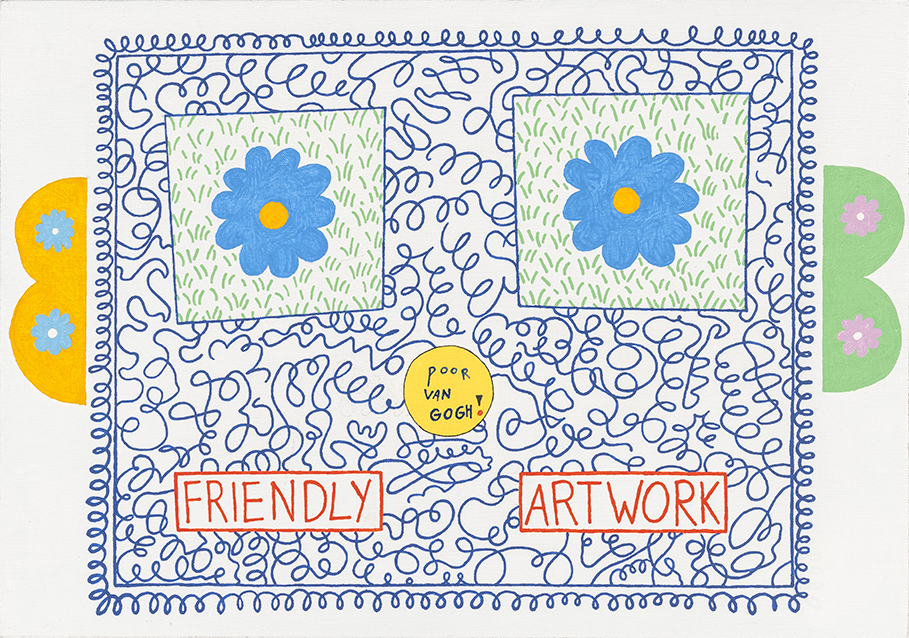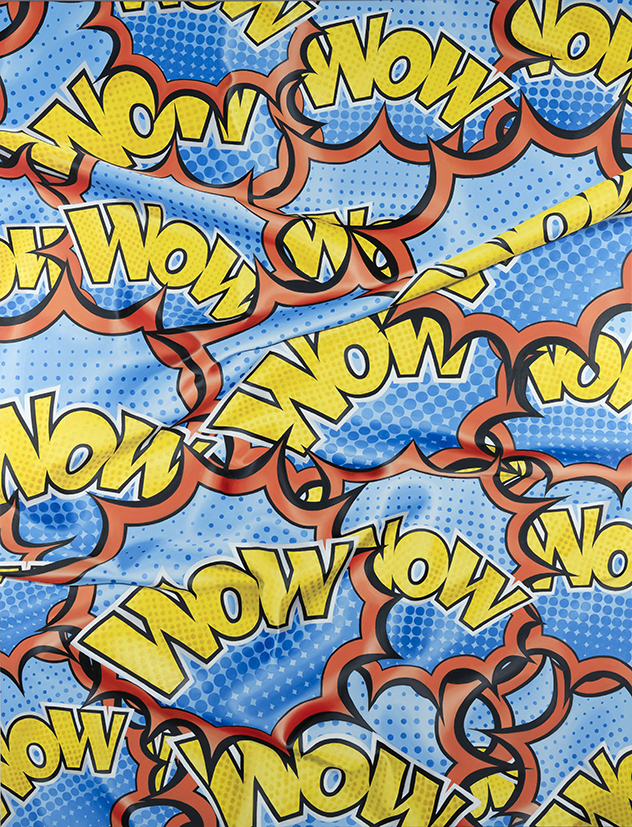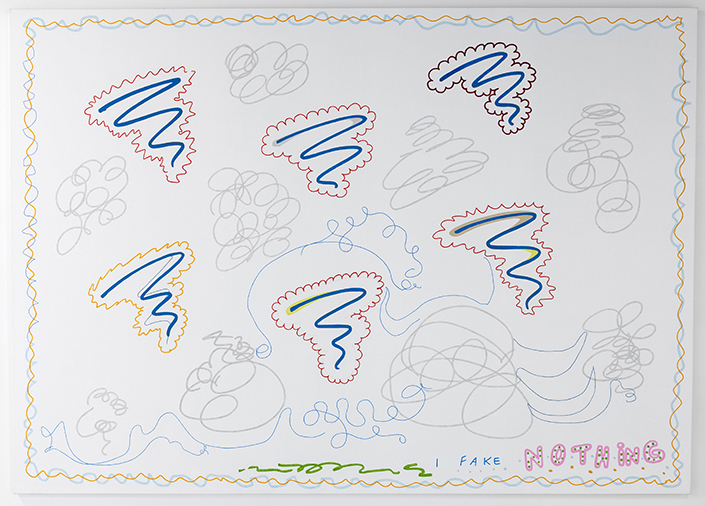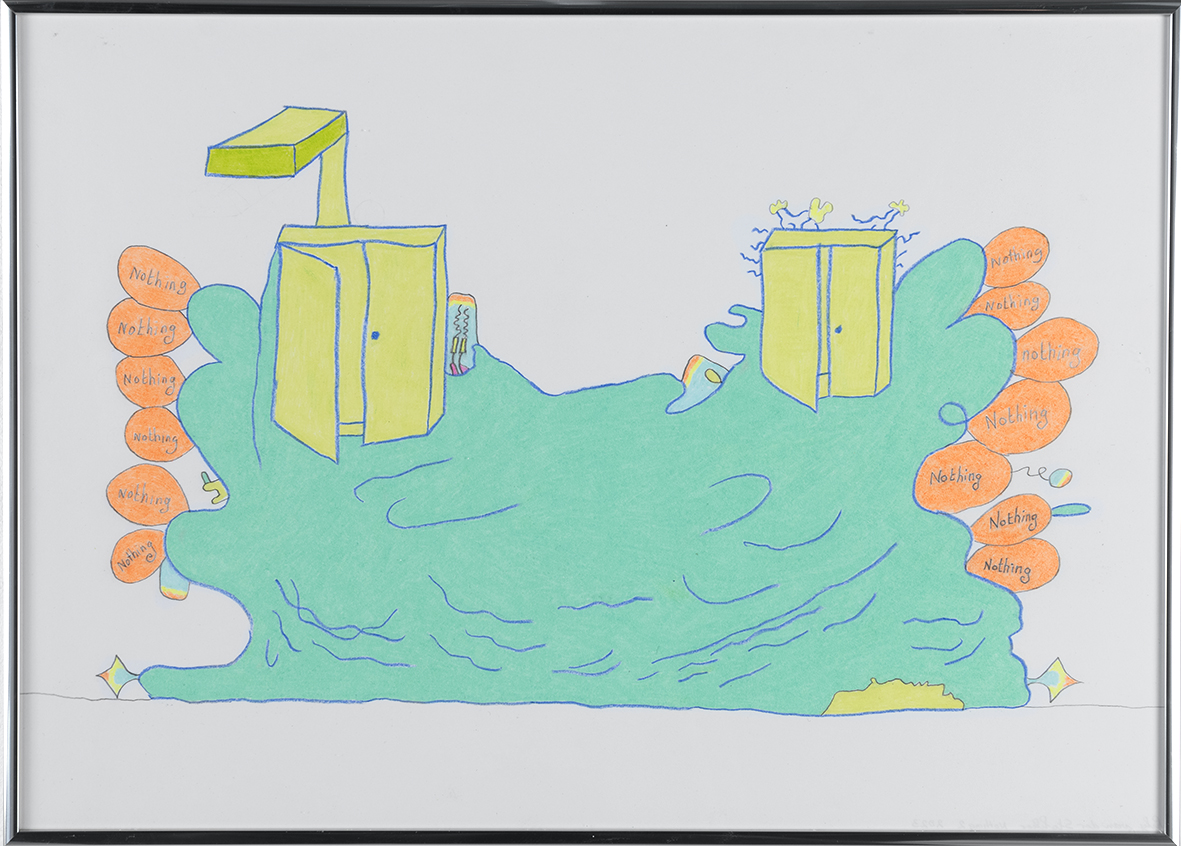

Eliza Douglas, Untitled, 2023. Oil on canvas, 210 x 160 cm. Unique. Photo Marc Domage.
• English version
• A propos de l'exposition / About the exhibition
Vernissage Romainville, le 9 septembre. Quelques silhouettes reconnaissables : célébrités locales, artistes, hustler, prêtres institutionnels et car-dealer s’affairent à des small-talks.
Eliza Douglas présente quatre nouvelles toiles en trompe-l’œil froissées ou distordues. Chacune d’elles scandent une onomatopée, un rythme bruitiste SHHHH, WOW, BOOM, HAHAHA et traduisent des émotions fortuites : une exclamation, une admiration, une stupéfaction, un agacement ou un rire inopportun. Elles sont installées en lévitation, le message de l’une renvoyant à l’autre comme des liens hypertextes. Elles pourraient être aussi la réponse d’une Joke Painting de Richard Prince, une version hyperpop de Incantation by Laughter (1910) de Velimer Khlebnikov ou du Hurra, Hurra, Hurra (1921) de Raoul Hausmann. Cliquer sur les pièces d’Eliza Douglas, c’est encore dériver sur les répétitions de Sturtevant, elles-mêmes renvoyant aux motifs de fleurs répétés d’Andy Warhol. Elles sont des images d’images, des peintures automatiques générant des émotions ataviques et standardisées. Sa procédure consiste à cristalliser des sentiments incontrôlés, à formaliser ce qui préexiste à la parole, à signifier –à la manière de la poésie concrète- des énoncés a priori impropres à nommer.
Ses bulles ou lacaneries pulp sont face au papier peint achetable sur commande de Lily van der Stokker, reproduisant une guirlande de pilules rosées, des motifs abstraits pastel comme une pochette d’album d’easy-listening aux vertus joyeuses et sédatives. L’artiste s’est fait une spécialité d’une forme mignonne et low key marquée par l’expression d’une candeur existentielle. Dans cet esprit, I fake Nothing est une série de dessins sur le rien bien que l’art qui prétend n’être sur le rien ne l’est jamais… Les spectateurs sont parfois trop obéissants aux énoncés d’une œuvre. Les motifs enfantins, nuages acidulés, guzzi-guzzi répondent par chuchotement au style brutal de ses consœurs de la post-picture generation que sont Barbara Kruger et Jenny Holzer. Ses couleurs layettes ou sablées minaudent les prétentions modernistes, « loufoquisent » les ambitions d’un art voué au grands desseins et transformations. Ses comptines graphiques sont adorables avec tout que cela suppose d’ambivalence entre compliment et condescendance. Le cute est toujours ici entre l’agression et la tendresse.
Ce vocabulaire mou, euphémisé, malléable, diminué ou faussement introverti est pourtant sûr de ses attributs : son pathos d’impuissance est en fait capable de produire une demande extrêmement puissante. On pense à l’exposition This is just pathetic qu’aurait vu Lily à New York à la galerie Colin de Land Fine Art en 1992, à Courtney Love et ses looks babydoll, à ses nuisettes blue-angel, ses peluches pouponnes et abîmées. Eliza Douglas et Lily van der Stokker ont assimilé la commodification du pop, du grunge, du post-pop, leurs ingénuités fautives et leurs dérivés publicitaires pleines de mansuétude, de détachement mensonger. Pensez à ces affiches privilégiant les adresses cosy, les personnages aux formes indolores pour vendre des médicaments ou des eaux gazeuses aux vertus digestives. Des CLIP ! CRAP ! des BANG ! des ZIP ! des PSHITT ! qui accompagnent nos angoisses d’accidents, de mutuelles, d’assurances ou de mal de gorge.
De manière plus souterraine, leurs techniques esthétiques sont des commentaires indirects aux obsessions de viralité du langage contemporain. L’annonce triomphe sur les faits, le bon mot sur la démonstration, la headline sur la dialectique. Seule compte la puissance de fluidité du message, sa reprise en nombre, sa capacité à gagner en surface au détriment de la compacité. Il peut alors devenir tyrannique, son onde radiante pulvérisant le temps d’appréhension et de doute. Les paroles ou signes accaparés par leur puissance cinétique privilégient la masse, la multitude, à l’individu qu’ils pulvérisent.
En laissant entendre qu’elles s’adressent au grand nombre, Eliza Douglas et Lily van der Stokker produisent des flatteries dévoyées, des bêtises malignes, des hard-candies pour adultes présumés innocents. En passant par des chemins déliés, des interférences : délégation, appropriation, reproduction, déflation, les deux artistes contreviennent ainsi à leurs apparences premières : ingénues, doucereuses et acidulés.
Vernissage Romainville, le 9 septembre. Les oiseaux de vernissage pratiquent encore le chit-chat « it’s cute », « It’s adorable », « It fakes nothing » « it’s wow »
L’avenir appartient aux foules éthérées.
Texte par Pierre-Alexandre Mateos & Charles Teyssou

Lily van der Stokker, Friendly Artwork Poor van Gogh, 1989. Acrylic paint on linen, 30 x 42 cm. Unique. Photo Marc Domage.
Opening in Romainville, on 9 September. A few recognisable figures: local celebrities, artists, a hustler, institutional priests and car-dealers are busy small-talking.
Eliza Douglas is presenting four new trompe-l’œil — crumpled or distorted — paintings. Each one of them utters an onomatopoeia, a foley rhythm — SHHHH,
WOW, BOOM, HAHAHA — and conveys random emotions: an exclamation, admiration, amazement, annoyance or inappropriate laughter. They are levitating in space, the message of one referring to the other as hyperlinks. They could also be the response to a Joke Painting by Richard Prince, a hyperpop version of Velimer Khlebnikov’s Incantation by Laughter (1910), or of Raoul Hausmann’s Hurra, Hurra, Hurra (1921). Clicking on Eliza Douglas’s pieces is like drifting onto Sturtevant’s repetitions, which in turn are evocative of Andy Warhol’s repeated flower patterns. They are images of images, automatic paintings generating atavistic and standardised emotions. Her process consists in crystallising uncontrolled feelings, formalising what comes before speech, signifying — in the manner of concrete poetry — statements that are seemingly inappropriate to name.
Her speech balloons or pulp, Lacanian quirks are shown in front of a wallpaper, available to order, by Lily van der Stokker. The latter reproduces a garland of pink pills, pastel abstract patterns, like an easy-listening album cover with its light-hearted, sedative properties. The artist has become a specialist in cute, low-key forms marked by a sense of existential candour. In this spirit, I fake Nothing is a series of drawings about nothing, although art that claims to be about nothing never really is... Viewers are sometimes too compliant to a work’s discourse. The childlike patterns, acid clouds and babbling are a whispered response to the blunt style of her colleagues from the post-picture generation, Barbara Kruger and Jenny Holzer. Her babywear or sandy colours simper modernist claims, "goofing up" the ambitions of an art dedicated to grand purposes and changes. Her graphic nursery rhymes are adorable, with all the ambivalence they entail — between flattering and patronising attitude. Here, cuteness always lies somewhere between aggression and tenderness.
This soft, euphemistic, flexible, diminished or deceptively introverted visual language is nevertheless confident about its attributes: its pathos of weakness is in fact capable of producing extremely powerful requests. We are reminded of the exhibition This is just pathetic that Lily would have seen in New York at the Colin de Land Fine Art gallery in 1992, as well as of Courtney Love and her babydoll outfits, her blue-angel nighties as well as her babyish, damaged teddy bears. Eliza Douglas and Lily van der Stokker have embraced the commodification of pop, grunge and post-pop — their misguided candour and their ad merchandising full of indulgence and deceitful detachment. Just think of the posters that feature cosy spots and painless character to sell medication or carbonated water with digestive properties. CLIP! CRAP! BANG! ZIP! PSSST! that accompany our fears about accidents, private health insurance and sore throats.
More indirectly, their aesthetic process comment on the obsession with contemporary language’s virality. The announcement prevails over facts, the buzzword over demonstration, the headline over dialectic. All that matters is the fluidity of the message, its reiteration, its ability to take up space at the expense of compactness. It can then become tyrannical, its radiant wave shattering the time needed for reflection and doubt. Words and signs, driven by their kinetic power, favour masses and the multitude over individuals, whom they annihilate.
By implying that their work is aimed at the widest possible audience, Eliza Douglas and Lily van der Stokker produce corrupt flattery, mischievous nonsense and hard candy for presumably innocent adults. By taking slippery paths, travelling through interference — delegation, appropriation, reproduction and deflation —, the two artists contrevene their initial naive, sweet and zesty appearance.
Opening in Romainville, on 9 September. Private view birds still practice chit-chat: "It's cute", "It's adorable", "It fakes nothing", "It's wow". The future belongs to ethereal crowds.
A text by Pierre-Alexandre Mateos and Charles Teyssou
(Translated by Callisto McNulty)

Eliza Douglas, Untitled, 2023. Oil on canvas, 210 x 160 cm. Unique. Photo Marc Domage.

Lily van der Stokker, I Fake Nothing, 2018. Acrylic on canvas (after a drawing from 1991), 200 x 290 cm. Unique. Photo Marc Domage.

Eliza Douglas, Untitled, 2023. Oil on canvas, 210 x 160 cm. Unique. Photo Marc Domage.

Lily van der Stokker, Abstract 1 2 3, 1988. Triptych, acrylic paint on linen, each: 20 x 60 cm. Unique. Photo Marc Domage.

Eliza Douglas, Untitled, 2023. Oil on canvas, 210 x 160 cm. Unique. Photo Marc Domage.

Lily van der Stokker, I Fake Nothing, 2018. Acrylic on canvas (after a drawing from 1991), 200 x 281 cm. Unique. Photo Marc Domage.

Lily van der Stokker, Nothing 2 (design for wall painting), 2019. Color pencil and pen on paper, 30 x 42 cm. Unique. Photo Marc Domage.